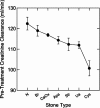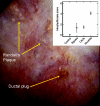Chronic kidney disease in kidney stone formers
- PMID: 21784825
- PMCID: PMC3156433
- DOI: 10.2215/CJN.10651110
Chronic kidney disease in kidney stone formers
Abstract
Recent population studies have found symptomatic kidney stone formers to be at increased risk for chronic kidney disease (CKD). Although kidney stones are not commonly identified as the primary cause of ESRD, they still may be important contributing factors. Paradoxically, CKD can be protective against forming kidney stones because of the substantial reduction in urine calcium excretion. Among stone formers, those with rare hereditary diseases (cystinuria, primary hyperoxaluria, Dent disease, and 2,8 dihydroxyadenine stones), recurrent urinary tract infections, struvite stones, hypertension, and diabetes seem to be at highest risk for CKD. The primary mechanism for CKD from kidney stones is usually attributed to an obstructive uropathy or pyelonephritis, but crystal plugs at the ducts of Bellini and parenchymal injury from shockwave lithotripsy may also contribute. The historical shift to less invasive surgical management of kidney stones has likely had a beneficial impact on the risk for CKD. Among potential kidney donors, past symptomatic kidney stones but not radiographic stones found on computed tomography scans were associated with albuminuria. Kidney stones detected by ultrasound screening have also been associated with CKD in the general population. Further studies that better classify CKD, better characterize stone formers, more thoroughly address potential confounding by comorbidities, and have active instead of passive follow-up to avoid detection bias are needed.
Figures




References
-
- Gambaro G, Favaro S, D'Angelo A: Risk for renal failure in nephrolithiasis. Am J Kidney Dis 37: 233–243, 2001 - PubMed
-
- Stamatelou KK, Francis ME, Jones CA, Nyberg LM, Curhan GC: Time trends in reported prevalence of kidney stones in the United States: 1976–1994. Kidney Int 63: 1817–1823, 2003 - PubMed
-
- Gillen DL, Worcester EM, Coe FL: Decreased renal function among adults with a history of nephrolithiasis: A study of NHANES III. Kidney Int 67: 685–690, 2005 - PubMed
Publication types
MeSH terms
Grants and funding
LinkOut - more resources
Full Text Sources
Medical
Miscellaneous

